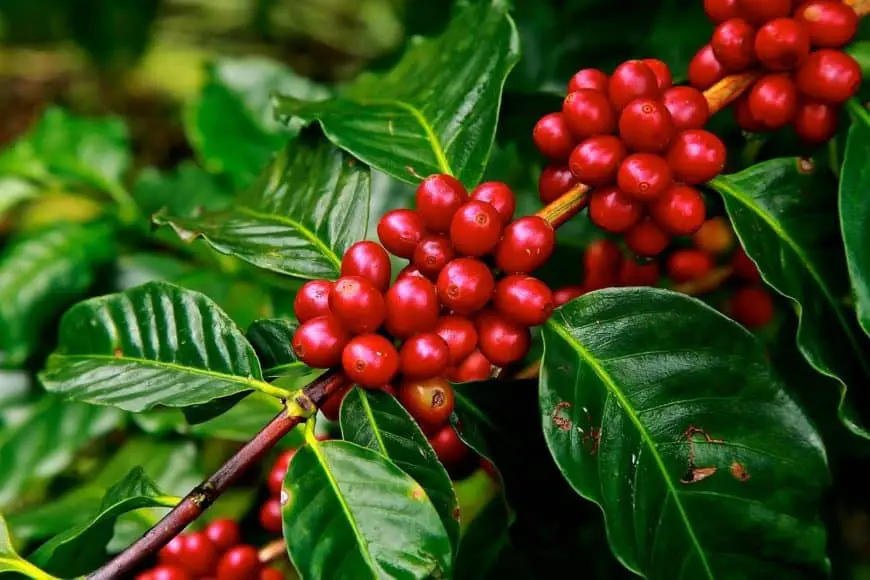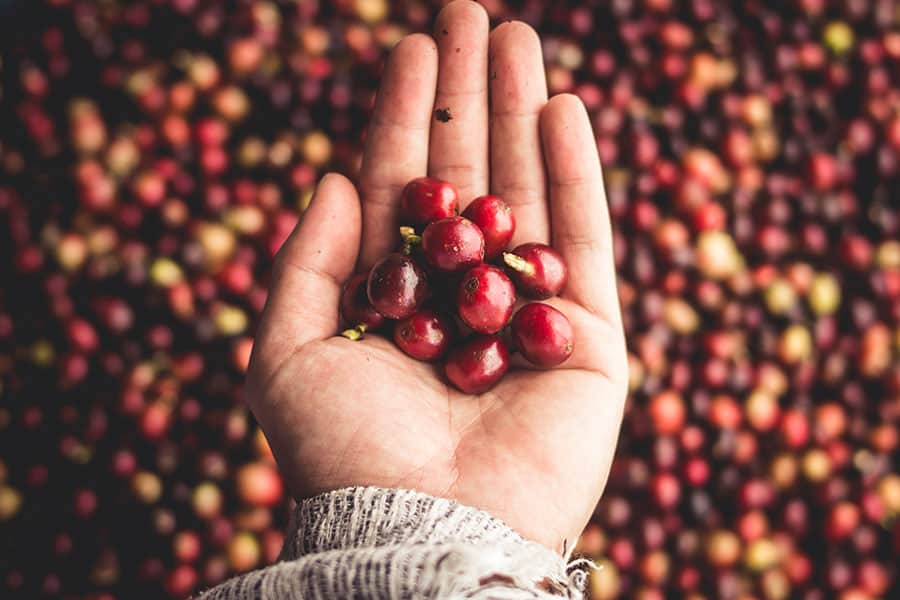
Most, if not all of us have heard of the word “coffee bean” but are not aware of what makes up the anatomy of a coffee bean and how it affects the taste of coffee.
We are often much more concerned, and rightfully so, about the taste of the coffee than the how this taste came to “bean”. I got curious about the anatomy of a coffee bean myself, so I did some research. Here’s what I found out.
What is the Anatomy of a Coffee Bean? A coffee bean is really 2 seeds that are side by side. The Main parts of the coffee bean (seed) are the silver Skin, Parchment, Pulp and the outer skin or pericarp.
As small as they appear, coffee beans are a composition of some natural compounds such as amino acids (proteins), carbohydrates, fiber, minerals, antioxidants, caffeine, and pectin.
With that long-winded intro over, let’s get into the actual Anatomy of a Coffee Bean!
What are the Parts of a Coffee Bean?
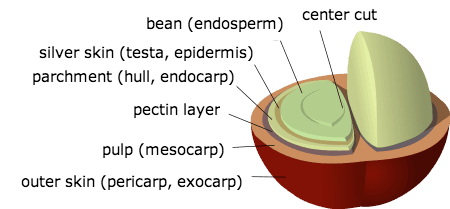
Parchment or Endocarp
This is a thick shell-like layer that surrounds the bean and is made up of 3-7 layers.
Mucilage (pulp) or Mesocarp
This is the “flesh” of the coffee fruit- during cherry maturation. This layer is rich in sugars and has a huge influence on the taste of the coffee bean.
Outer Skin or Epicarp
The outer layer or skin of the cherry. At the beginning of fruit development, the skin is green and as the fruit matures, it turns yellow, then orange and then a ripe red.
Pectin
This is responsible in protecting the coffee beans. It’s made up of a cellulose layer
Endosperm
Factoid: With all the coffee that is harvested each year only about 5% have a single bean inside (usually there are 2) When this happens, they call it a peaberry and this type of bean, if roasted correctly, will be sweeter and have more flavor then a typical coffee bean. This makes them more valuable and are sorted separately.
Natural Compounds of Coffee
The natural compounds that are inherent in a coffee bean are amazing and surprising, so I am going to tell you more about each of these organic components that make up a coffee bean:
Amino Acids
As amino acids are the protein building block in our bodies, the same case applies to coffee. Upon roasting of the coffee beans, free amino acids tend to disappear. Coffee beans contain 3 amino acids, namely: glycine, glutamic acid, and aspartic acid.
Carbohydrates
Carbohydrates make up about 50% of a coffee bean and the soluble sugars of roasted coffee contain glucose, sucrose, and
Fiber
Minerals
Coffee beans contain several minerals in different small amounts. These minerals include calcium, magnesium, phosphorous, potassium and zinc and go along with vitamins like folate, vitamin B-6, thiamin, riboflavin, and niacin.
Antioxidants
According to medical sources including sites such as WebMD, coffee contains high levels of antioxidants which can reduce the effects of type 2 diabetes, colon cancer, liver cancer, gall stones, cirrhosis of the liver, and Parkinson’s diseases
One secret you probably didn’t know is that magnesium exists naturally in coffee. When this antioxidant blends with the magnesium, they are believed to lower blood sugar.
Caffeine
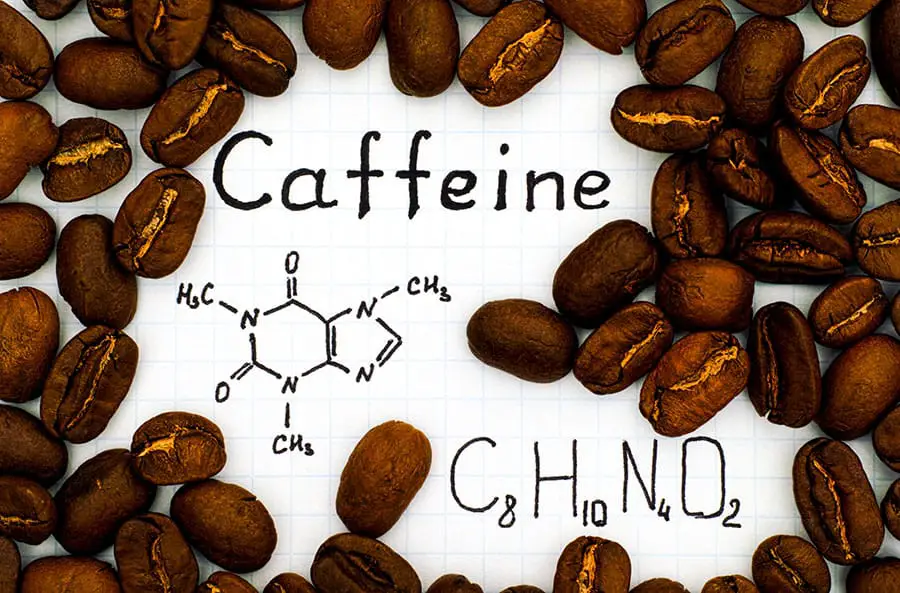
This is a major active component of coffee beans. Different coffee beans have varying amounts of caffeine. This depends upon the coffee bean size. You may also be interested to know that the weight of coffee beans determine the amounts of caffeine present.
Pro Tip: Contrary to popular opinion, Coffee beans that are roasted for a shorter period of time and are called “light roasts” actually contain more caffeine. Whereas when coffee beans are roasted longer, for example “dark roasts” they become “lighter”, hence contains less caffeine.
The Size of Coffee Beans
Do you know that coffee bean sizes are as usually referred to as coffee grades? Some of the factors that affect coffee bean size include its elevation and type, for example Arabica and Robusta. Let me briefly explain the difference between these two before going any further:
Arabica Coffee
This type of coffee does well in areas with high altitudes, with temperatures of around 60-80 degrees Fahrenheit. Coffee beans here contain a few caffeine levels.
This explains why their acidity amounts are less. They are flat and stretched out. This is the delicate coffee type that requires intense cultivation labor. They are also highly susceptible to pests and diseases. Their delicate nature explains why Arabica coffee beans are expensive.
Robusta Coffee
This type of coffee does well in lower altitudes, with a steady temperature of between 75-85 degrees Fahrenheit. It usually has more caffeine which explains it’s bitter nature. and are considered lesser quality than Arabica Coffee. However, Robusta coffee bean’s value is seen in its espressos as it has a strong more caffeine and crema plus a pleasant flavor that makes you keep coming back for more.
If you are interested in more details about the differences between Arabica and Robusta coffee, you can find a more indepth analysis here.
A Screen to Determine Coffee Bean Size
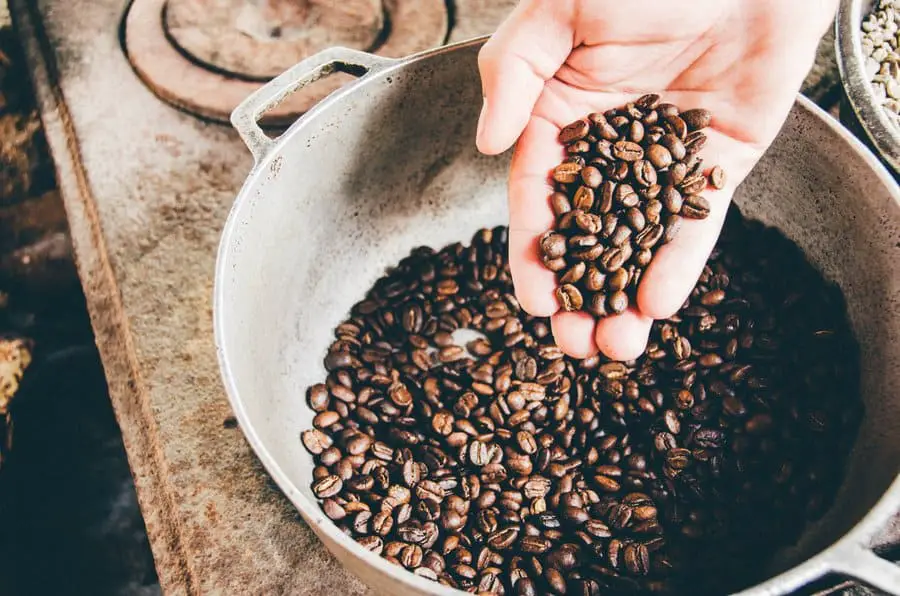
Most countries that specialize in coffee will use a screen sorting system for categorizing coffee bean sizes. The screening method was started with the idea that coffee that comes from high altitudes are bigger and heavier than those of lower altitudes.
The bean size screen sorting system has been and continues to be increasingly used as the evidence show a strong relationship between coffee bean size, weight, and quality.
Its interesting to note that a different screening numbers are used for Robusta and Arabica coffee.Robusta coffee uses odd numbers and Arabica coffee uses even number for grading and to differentiate the two.
The screens themselves are metal strips of varied sizes and holes with the numbers 8 to 20 which correlates to that number over 64 and is inches. For example if the size is 8 then then the coffee bean size is 8/64 of an inch. Hopefully, I didn’t make that too confusing! For Arabica beans the bean sizes are broken down as follows:
- Size 20 – The largest bean size and can be referred to as “elephants”.
- Sizes 16 – 18 – Large Size Beans can be referred to as, Superior Supremo or AA depending on origin
- Size 14 – Medium Size Beans – Can be referred to as Segundos, Excelso or AB depending on origin
- Size 12 – Small Beans – Can be referred to as Caracol’s
- Sizes 8 – 10 Shells
Coffee Bean Rating Terms
This refers to such names as you may have seen before on coffee bags. They say things such as AA, Altura, Excelso, Hard Bean, SHB, SSB and Supremo. and mostly refers to coffee bean size. However, the same term may refer to different things in the coffee field.
Here are some common coffee grading and classification terminologies:
AA
This is a coffee grading word that implies coffee bean size that is abnormally larger with specific features. Some are too big to penetrate through certain grade sieves. AA as a term links coffee bean size to the coffee aroma.
Excelso
This is a coffee grading term mostly used in Colombia. It’s however used at least in many other coffee regions. Coffee beans here are slightly larger. They can, however, penetrate through grade 16 sieves, unlike the AA. Coffee grading aspect here also connects coffee bean size to coffee taste.
Supremo
Although the term is widespread in different countries, it’s also used as a coffee grading term mostly in Columbia. Coffee beans here are way larger than those of Excelso.
They can penetrate a grade 18 sieve. Both Supremo and Excelso originate from the same tree. However, their variations come about during the sorting by coffee bean size and coffee bean anatomy. Supremo also associates the bean size to the coffee taste.
Altura
It refers to coffee grown in high mountain regions. The term has a Spanish origin.
The specialty coffee association in America ranks coffee bean size as either specialty or below specialty grades. In some places, coffee grading is based on coffee bean anatomy factors like hard coffee bean and soft coffee bean. In cases like this more factors are considered then just the size of the bean
Ranking Coffee By Grades
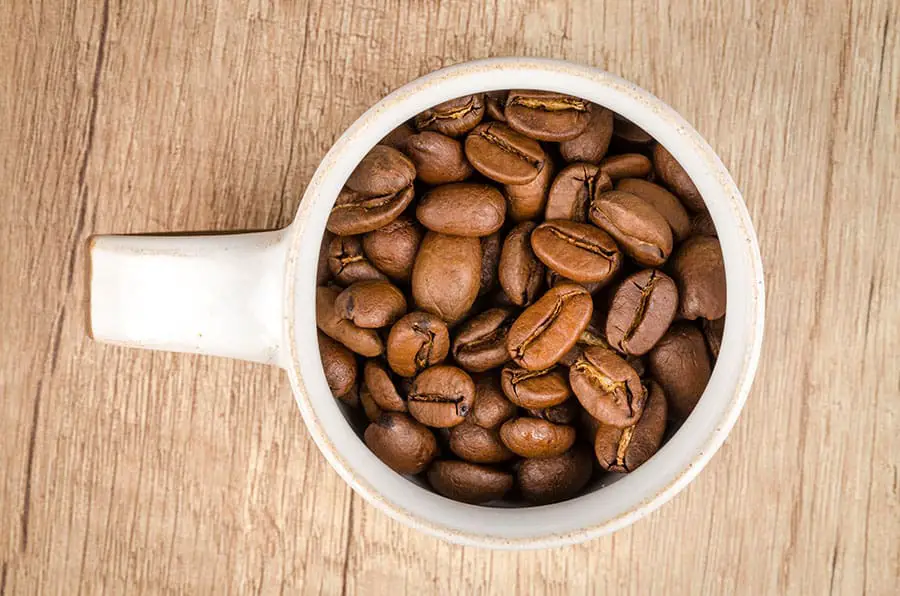
This is used by the Specialty Coffee Association of America and is generally considered the standard system to rank specialty coffee. The reason this system is slightly different is due to the number factors they take into consideration besides bean size such as:
Hard Bean (HB)
This refers to coffee grown at altitudes of around 4000ft over the sea level. Due to such altitudes, the maturity period is longer. The bean also grows to be heavier and harder than those grown at lower altitudes.
This connects to the name, Hard Bean (HB) or hard Grown (HG). However, they have pleasant flavors and are quite expensive.
Strictly Hard Bean (SHB)
They are found in altitudes over 4500ft above sea level. Its qualities resemble that of HB. Their maturation period is also longer. They grow to be harder and weighty. They have a pleasant taste that makes most coffee lovers appreciate the brand.
They are also pricier than coffee grown in lower altitudes. When you hear the term Strictly High Grown (SHG), don’t be perplexed. It’s one and the same as SHB.
Strictly Soft Bean (SSB)
Grown at lower altitudes, less than 4000ft above sea level, their maturation period is faster. As the name suggests, they also grow to appear softer and denser
When they have considered all these factors they come up with a grading system that ranges from 1 – 5 and is broken down as follows:
- Grade 1- referred to as the specialty grade of coffee bean. It contains no major flaws. The sorting criterion here is a maximum of 5% over and 5% beneath the exact screen size or the screen size level. It produces exceptional coffee qualities mostly in terms of flavor
- Grade 2 – this is termed as fine grade coffee beans. It’s almost close to grade 1. The difference is that it has a defect allowance level of 0-8.
- Grade 3 – this grade falls under the exchange category. The sorting criterion here is a maximum of 50% over screen 15 and 5% beneath screen 15. The defect allowance level is 9-23
- Grade 4 – referred to as the typical grade of coffee beans. Has a defect allowance level of 24-86
- Grade 5 – referred to as the off-grade category of coffee beans. Has a defect allowance level of over 86.
Final Thoughts
I hope this gives you a better understanding of the anatomy of a coffee bean and that you have a greater appreciation of all that goes into the making of this fruit.
The next time you buy a bag of coffee from your local roaster, or the next time you sit down for a cup of coffee at your local coffee shop or at home consider how far its has come to get there.

